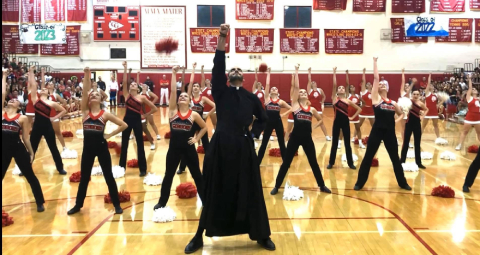November 22 | ![]() 0 COMMENTS
0 COMMENTS ![]() print
print

The everyday life of a Catholic school chaplain revealed
It surprises so many people that the mission of a school chaplain is not restricted to the Religious Education department. This is because Faith breathes in every corner of a Catholic school community, from the classroom to the sports field, from the social space to the staff room.
By Fr Michael Kane
This week Catholic Education is once again in the spotlight. As a tonic to the often negative press around Catholic schools in some quarters, this week gives us all an opportunity to celebrate everything that is good and life-giving about our schools. It’s also a chance to reflect on our own positive experiences of Catholic schools and to contribute those experiences to the on going national debate around religious schools.
At a time of intense conversation on this topic, we should not withhold our vocal support for a system we were all fortunate enough to benefit from.
This week I reflect on the ever-changing work of school chaplaincy. Since my ordination some eight years ago, I’ve worked continuously in primary and secondary school chaplaincy. In that time I’ve seen the role adapt to a constantly changing environment.
Duties
In particular, the practice rate among pupils and staff has fallen, with all the implications that has for the ethos of any Catholic community. I myself have also had to adapt my relationship with the schools I serve. Gone are the days when school chaplains were curates with few parish responsibilities. Modern day chaplains are often parish priests with other schools to look after, alongside a myriad of other pressing parish duties.
So what exactly does the work of a school chaplain entail? Much of my time is spent celebrating regular early morning Masses, leading public prayer or other liturgies. Much of this activity is guided by the Church’s seasons.
For example, in this month of November we celebrated a Remembrance Service and held other services to commemorate the Faithful departed. Our young people wrote November lists with the names of their departed family members and placed them before the altar in our Oratory with the promise of prayer.
Likewise, Holy Days of Obligation and feast days are important days for us when the whole school family gathers to attend Holy Mass. This gives a chaplain an opportunity to speak with the entire school community about a particular theme, and reminds our young people of the vital importance of certain religious feasts.
Devotions and prayers
I also hear confessions and support our chaplaincy team to deliver a programme of devotions and prayer initiatives which form an essential part of the school schedule throughout the year.
In Lent, I celebrate daily Mass for our pupils and staff as a means of marking that penitential season; in Advent we gather for Adoration; in May and October the Rosary takes centre-stage in lessons and in our prayer time.
In ordinary day-to-day school ministry, my work includes visiting classes and engaging with the pupils. Chaplains are often asked to speak to pupils in science or social subjects or in other departments. In the past I’ve found myself engaged in robust debates among our senior pupils in RE classes.
We also speak extensively about the perceived tension between Faith and science. These debates, which are usually lively (and brutally honest!), are important to remind our young people that the Church is not afraid to engage with the serious questions they carry in their hearts.
Caritas
We also work with the Caritas group in the school and walk with them through the steps towards receiving their award. For me one of the greatest things about being a chaplain is seeing the spark of Faith re-ignite in many of these young Caritas pupils who wandered from God in their earlier years.
Caritas is a great means of fostering a new love for God in the hearts of our young people. It also inspires in them a love for serving others in the midst of a world which is full of self ambition and egoism.
In reality much of the work of a school chaplain takes place away from the classroom and oratory.
Chaplains make themselves available to speak with staff members or pupils who find themselves in need of some spiritual guidance or support.
Ministry
Often this means speaking with those who are grieving the loss of a loved one, or offering a prayer for a family member who is sick. Sometimes it means praying with a pupil crippled with nerves before an exam, trying to bring healing to a young person suffering with depression or praying with a dinner lady before an operation.
School chaplains are privileged to get this close to people’s lives. Our work is not especially wonderful but our presence is a signal to these communities of Faith that their priests are near to them, interested in them and walking alongside them.
It surprises so many people that the mission of a school chaplain is not restricted to the Religious Education department. Our work is broader than that. This is because Faith breathes in every corner of a Catholic school community, from the classroom to the sports field, from the social space to the staffrooms.
Our task, and the task of every Catholic educator, is to allow the Gospel to permeate into every area of a school family no matter what we are doing. It is impossible to understand Catholic schools if we do not understand this unique characteristic. This Catholic Education Week, let’s add that perspective to our national debate.










